Mobility

Renewable mobility, a combination of e-mobility and energy transition, is considered the crucial key to achieving a real emissions turn, and with that the agreed climate goals. Nevertheless, the turn is affecting major corporations in the automotive, oil and construction industry. The mobility industry is now on the verge of upheaval. But it is not only ambitious climate goals that call for action. It is the economic success of renewable energies worldwide that, in combination with digitalization, is changing the predictions and shifting decarbonization by 2030 into the realm of possibility. This is already shown by current applications.
By Christiane Schulzki-Haddouti. Translated by Alexandra Bartelt & Denis Francis
In the German transport transition, the focus was on on-board efficiency measures for a long time. But because of the increasing traffic capacity and increased motorization, emissions were slightly higher in 2016 than in the base year 1990. The transport sector, alongside industrial production, are the only ones in which greenhouse gas emissions continued to increase in 2017. In 2018, the German Advisory Council on the Environment, which advises the Federal Government, came to the conclusion that a switchover to alternative drives has to be made as soon as possible. Complete decarbonization, a greenhouse gas-free Germany, is now in the focus of the efforts. The target for this is still the year 2050. According to the latest report by the Intergovernmental Panel on Climate Change, it is clear that the deadline has to be moved forward as far as possible. Some consider a target of 2030 to be possible.
At the moment, e-mobility is seen to be a great harbinger of hope. It is not yet really clean. During the production of electric cars, considerable amounts of greenhouse gases are emitted into the atmosphere. To even out the carbon dioxide released during battery manufacturing and the electricity needed for operation with today’s power mix, electric cars would need a total mileage of around 150,000 kilometers. The balance is only improved when the production is gradually changed to clean electricity. It will look even better if vehicles get their electricity directly from solar and wind power.
Many countries such as Norway, India or China push for an exit from combustion engines by stating a concrete end date for new vehicle registrations such as the year 2035 or quotas for e-vehicles. Still, economic decisions seem to be more important than political choices. This is why the current dynamic cost reduction of renewable energies could prove to be an important driver of the development. In 2014, Stanford professor and Silicon Valley entrepreneur Tony Seba pointed out that the efficiency of photovoltaics (PV) is developing exponentially just as the Internet did in the past. He expects that the worldwide energy demand can be covered by solar power in 2030. From a German point of view, Seba’s prognosis does not seem to be very realistic. But according to a report by the World Economic Forum, solar and wind power cost the same as energy sources coal and natural gas in 30 countries in 2017 .
Seba expects that the costs for e-vehicles will decrease as fast as those of solar panels. The costs for photovoltaics have decreased by 22 percent for every doubling of industry capacity because of a learning curve of 22 percent. The disruption will be reached when the monthly costs for an e-car are close to those of a vehicle with an internal combustion engine. The costs of batteries are not pivotal, because similar to the competition between the smartphone and the landline, an e-car is not a replacement for a conventional vehicle. The electric motor is more energy-efficient, the charging cheaper and the maintenance easier. E-cars can also be used for energy storage and therefore contribute to the stabilization of the power supply system.
Fewer Vehicles Because of Digitalization
Tony Seba is not the only one who is of this opinion. Karl-Thomas Neumann, former head of the Adam Opel AG until 2017, who worked for the Californian e-vehicle start-up EVelozcity, agrees with Seba. In the Handelsblatt, a German newspaper for business and economic issues, he said recently. “In reality, this is all disruptive and in the end it will completely destroy the existing industry.” He therefore recommends that large companies invest in the new business with adaptable start-ups. EVelozcity want to roll out their first electric vehicle in 2021 and they set their hopes on commuter cars, ridesharing and delivery vehicles to reach their goal. Rather than having range as the distinguishing feature, it is actually having a price of less than USD 50.000 that is important. This is made possible with components from the US and China.
The market is therefore shaken up from the top. Today, Tesla dominates the US-American market in the price segment of high-quality limousines, and the segments in the lower price range will follow. This development is followed with a sharp eye at the stock exchange. Already in 2017, Tesla was rated higher than the traditional US car manufacturers General Motors and Ford. It looks similar for companies like Alphabet or Mobike that pin their hopes on digitalization in mobility. Studies of the Wuppertal Institute such as the one regarding the transport transition 2035 expect that the transport sector could get by with only one tenth of the number of today’s cars, if the possibilities of digitalization of autonomous driving and ridesharing are used consistently.
California is far away. But there are also considerable changes in Germany, although on a small scale — in a vast and windswept area in Northern Germany. The region of Northern Friesland is currently a pioneer in the expansion of charging stations and the number of vehicle registrations of e-cars in Germany. In the Friesian municipality of Sprakebüll for example, there are 20 registered e-cars for every 240 inhabitants. The inhabitants of Sprakebüll did not accept having their wind turbines switched off when the electrical grid was in overload, so they looked for alternative possibilities to use the generated power. Sprakebüll claims to have the highest density of e-cars per person in Germany. If the entire country functioned as this municipality does, there would already be seven million e-vehicles.
In a blog entry, the small municipality celebrated itself as an e-mobile village and the inhabitants founded an association of the same name. The association provides its members with e-carsharing for an hourly charge with the so-called ‘Dörpsmobil’, which is charged at its own carport. This development is being promoted by the Andresen family. “We wanted to use our own electricity and not petrol from the station”, say Hans-Christian Andresen and his son Christian, who serve as CEOs for the communal citizen-owned wind farm. But the inhabitants of Sprakebüll are not yet satisfied with their achievement. In the future, they want to supply agricultural vehicles with fuel generated from the electricity from the citizen-owned wind farm.
Also in Northern Friesland, there are currently tests with three autonomous e-buses to try out public transport ‘on demand’. After the tests on the site of the GreenTEC Campus in Enge-Sande, the buses are supposed to be used in commuter transport in Northern Friesland and in tourist traffic on the island of Sylt. The passengers are supposed to call for assistance using an app and the new bus service will thus be able to close mobility gaps in rural areas. Besides the SVG and Autokraft bus companies, many specialized companies as well as Christian-Albrechts University in Kiel are working on the North Frisian bus project.
Digitalization with its advantages for networking is the game changer in the transport transition. It allows the use of decentralized structures efficiently with relatively little effort and expense. In regard to the resilience of networks, a decentralized management is crucial, which means e-cars play a new role as mobile batteries. As early as 2013, a report by the California supervisory authority for public utilities came to the conclusion that owners of e-cars could be paid up to USD 100 a month if they provided electricity to stabilize the power supply system.
Mobile storage power plants
At the moment, however, the public debate on the expansion of e-mobility is still dominated by the question of what happens when the many new e-vehicles charge every evening, causing overloaded power lines at the municipal utilities. This question focuses on a centralized provision of energy — but not on decentralized power generation, which would already be possible on site with today’s state-of-the-art technology. It is a little reminiscent of the discussion in the late 1990s, when it was suspected that the livestreaming of voice messages and moving images would completely overload the internet. Shortly thereafter, companies like Skype launched successful voice and video services using peer-to-peer technologies.
E-cars and computer junctions could play a similar role in a peer-to-peer structure and store energy when there is a surplus of sun and wind energy production in order to be able to release it in a controlled manner in the event of bottlenecks. A current project in rural Allgäu (part of the alpine region in Bavaria) shows that this works. Together with the Research Centre for Energy Economics in Munich, the Augsburg utility company LEW has set up a project at the Buchloe train junction, where many commuters board trains to Augsburg or Munich. All 14 research participants were provided with an e-car, which they were to connect to the electric vehicle charging stations, also called EV charging stations, at the train station every evening. They were then supposed to indicate the time at which they will arrive at the EV charging stations on the following day. The charging schedules for the car batteries were calculated on the basis of the data and forecasts for insolation. As a result, the vehicles were able to absorb 40 percent more of the local green electricity and avoid peak loads in the grid.
Often technical rules still interfere with the integration of e-mobility into the grid. For example in Hagen, in October 2018, Nissan and The Mobility House (the EV charging station manager) started their vehicle-to-grid-project. Only after years of preparatory work was it possible to meet the regulatory requirements for the so-called primary reserves of power plants. Now connected e-vehicles automatically register with the energy center in Hagen as a control power system and are integrated as such into the power supply system. In this way, they can contribute to the stabilization of the power supply system and reduce the cost of expanding the grids and the need for fossil-fired control power systems. In Germany, this is regarded as the biggest problem which transport transition supporters criticize. Despite the long technical lead time, there are still no standardized adjustments to facilitate the integration of e-mobile storage power plants.
The founders of Ibitricity, a Berlin startup, have been working on the idea of bidirectional charging since 2008 — they also had to overcome countless regulatory hurdles. After years of collaborative research, pilot projects and field tests, they have been on the market since 2016 with a cable which can even be used for direct billing. It has been compliant with the calibration law since 2018. Since 2013, they have been represented in Berlin with their charging infrastructure on several street lights. However, the breakthrough came in 2017 with a major contract from the London municipal administration.
Speaking of regulations, it is especially mentioned when it comes to the question of why the development of e-mobility in Germany is lagging far behind expectations. It is the construction and property law, the charging across supplier boundaries, the calibration and measurement law and a resilient network expansion that hinder the expansion. If policy makers now want to speed up this process, they have to tackle all this and even more whole heartedly. If they force the energy and automotive industry onto a sustainable path, it will do them and society more than one favor. Otherwise the economic disruptions could be severe.
Christiane Schulzki-Haddouti is a freelance media and IT journalist who has been involved in different projects in the areas of foresight, innovation management and media development. She mainly writes for c’t, a computer magazine, VDI-Nachrichten (a news portal for engineers), the Stuttgarter Zeitung (daily newspaper in Stuttgart) and also for online portals like Heise online (news on computers, IT, science and politics) and Golem (IT news). Together with Christopher Schrader and Alexander Mäder, she founded the KlimaSocial channel on the Riffreporter platform (an online platform publishing projects and research about coral reefs). The main question is: What is really driving climate protection forward — is it politics or are completely different factors involved?
More articles on the topic of mobility and transport transition you will find in our correspondent factory-magazine Mobility. This you can download free of costs and it is pleasantly readable on screens and tablet-computers. As every time it is also nicely illustrated and contains all articles in the compact tablet-format plus appropriate numbers and citations. Online in our topics section a few articles are also available – there you can comment and rate them.
Beiträge online
MOBILITY

- Decarbonization by 2030
- Cities Use the Space
- The Domino Effect: the Mobility Transition as an Engine for the ‘Great Transformation’
- Mach die Wende!
- Guter Verkehr ist reine Ökoroutine
- Von der Automobilindustrie zur Mobilitätsindustrie
Themen
- The Domino Effect: the Mobility Transition as an Engine for the ‘Great Transformation’
- Cities Use the Space
- Decarbonization by 2030
- The fear of biting the hand that feeds you
- Where investing is a pleasure
- Why divestment is going to change the world
- A Robin Hood tax for climate protection
- May the Force Be with Us
- Modern Strategies
- The prerogative of interpreting the future now lies with the companies involved in climate protection”
- From Negotiating to Trading Equitably
- Can a donkey be tragic?
- Rethink rather than rebound: a sufficiency revolution must precede the efficiency revolution
- On Rebound, Prebound and Performance Gaps
- So Let Us Seize Power Then!
- With Common Property Against Political Failure
- So Let Us Seize Power Then!
- The Comforting Beauty of Failure
- “It Is Not Impossible at All.“
- Resource-light shopping
- Men Have Not Stopped Giving the Advantage to Women – So Far
- Toothpaste for Princesses and Soup for Pirates
- It is about equality
- A nice day
- Initiative instead of frustration
- The right ingredients
- Resilient for Life
- Not only, but also
- Appreciation – more please!
- Worth more than money
- Learning to value the value of goods
- Worth and Values
- The Transformative Power of Science
- Historically effective: How innovation and technology transform
- The Disappearance of Products
- Growing Older 101
- Columbus’ Egg
- It Works! In Theory at Least ...
- What If...?
- Analysing Separately – Thinking and Acting Together!
- Let’s Break Away from Determined Breaking Points
- More Gold in Waste than in Mines
- The art of separation
- Should you really DIY?
- The Aesthetics of Do-It-Yourself
- Standing on One’s Own Feet
- From the handaxe to desktop fabrication
- Using Shares to Survive the Crisis
- When Citizens participate
- Possess to Participate
- The Right Growth at the Right Time
- Gunter Pauli and Blue Economy
- When Sustainability Grows
- How we treat Growth
- Illusions about Growth

